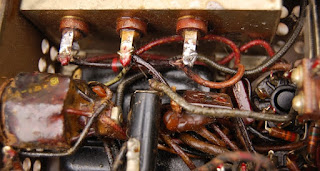Not clearly depicted in the above shot is a socket for a third 6V6 (next to power transformer), which I understand was employed in the optical pickup circuit. The optical section, unless I am wholly mistaken (which is highly possible since I haven't invested a lot of investigation into the moving pictures realm of audio technology) appears to utilize amplitude modulation to bridge the span between variations in the intensity of light (as passed through the clear line of varying width that is the early analog audio track on film) providing a signal that is then fed through a modulation stage that spits out audio. As stated, I don't have a firm grasp on how that system does what it does; I do understand that the optical signal handling systems can be removed for use as an amplifier.
The 6J7 is, again - as I understand it, the crucial first gain stage of both optical and 1/4" line input, and so removal essentially renders the amplifier inoperable. I do dig the tube designator branded into the octal socket itself. This amplifier came from the bad amp room haul, in one of the "pending project" heaps. I worked with the guys who built those heaps for years, and I wouldn't be surprised if the 6J7 was plucked due to its proximity to the "mysterious optical thingy", and, after the amp no longer functioned a quick jaunt across the street to the liquor store was embarked upon through which another bottle of cheap blended scotch was procured. Bottom's up!
I'm being too hard hard on those two, and even though I highly doubt either of you are reading this - "Cheers, we had good times and I learned a lot!" Best for the future, my friends. Anyway...
It's at this point that I started scratching my head. Overlooking for a moment the absolute congestion of parts in this chassis, the single most terrifying aspect is the glossy residue over all of the parts. It's like a glazed doughnut in there.
Of course, there's not a readily visible electrolytic in the entire amp. There are, however a couple multi-section oil filled bathtub caps, and while I haven't searched the amplifier for a date code (opting to not mess with the interior at all) judging by the amp itself (topology, finish, tube selection, supporting component types) it is a safe bet that this amplifier predates the ban of domestically produced polychlorinated biphenyls. So, if that sheen is from the oil can cap leaking, it is possible the guts are steeped in a persistent organic pollutant.
Mmmmmmmmm, organic.
So, with the notion that this amp may be brimming with PCBs (and I do acknowledge that I'm leaning on exaggeration with "steeped" and "brimming", but even trace is too much with this stuff) I'm more or less steering clear of physically poking around in there for the moment and sparking up some side conversations regarding the compound mystery.
The following is a response by RGR in my first knee jerk assumption that there are in PCBs on hand:
When I was stationed in California we saw the extremes to which PCB contamination would be handled. A pole mounted transformer blew. In the de-installation of said tx it was dropped and landed on the terminals. The integrity of the case was seriously compromised and the coolant leaked onto the pavement. ALL activty ceased. Disposal crew arrives in full " moon suits ". Tx is loaded into a large container and sealed. What I gathered to be vermiculite was used to sop up that good 'ol gravy and the loaded into another specialized container. The pavement from the point of impact to a radius of 15 feet out was removed and placed in specialized containers. The de-con of equipment used was carried out in essentially a clean room that was set up specifically in an aircraft hanger. My understanding was that new transformer was now worth north of $150K ( 1987 dollars ) due to all aforementioned activity.We were taught and told if the case of a cap or tx was compromised you GTFO and contacted the hazardous waste response team by way of time machine before it happened. Paranoia was S.O.P. with PCB's.
Moon suits.
DPN forwarded the idea that it may not be oil at all, but shellac, coated intentionally to ward off oxidization and moisture. To paraphrase:
These were film projectors, they wound up out in the middle of nowhere, like the jungle. They'd hump a big trunk of cable out into the bush and show films about syphilis or Jesus to the natives.
Naturally, I prefer the idea of shellac over PCB enriched capacitor oil. I remain a little skeptical however, as doping mechanical contacts with shellac seems like a fast way to make them stop working. We've got tube pins, power switch, a leaf spring loaded input channel switch tied to the 1/4" input and of course potentiometers.
In hunting about on the internet I came across a thread in which someone else had a similar problem, and opted to blast the insides of the amp with brake parts cleaner. This is not a course of action I'll take, as that doesn't clean the inside of the amp, rather, it spreads the pollutants out - making a bigger mess. I'm looking into my local hazardous materials testing options, and am refraining on cutting a decision until I've consulted the professionals, presuming of course investigations do not overshoot the value of the amp (by my cheapskate mathematics).








No comments:
Post a Comment